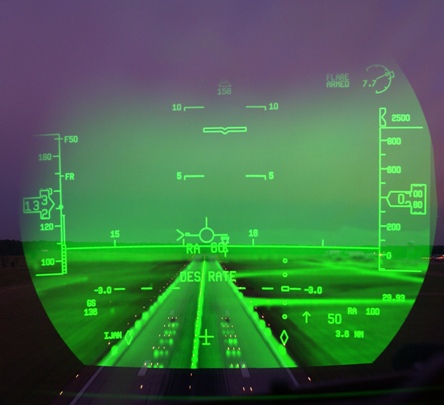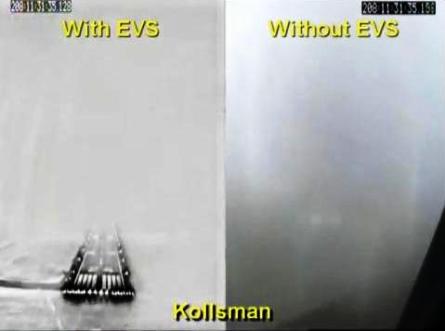Cargo airline FedEx has received an exemption from the US FAA that allows the carrier to use a combination of vision enhancing equipment, procedures and training to expand foul-weather access to US airports.
The 24 December 2009 approval, the first of its kind for the airline industry, permits FedEx to begin performing instrument landing system (ILS) approaches with ground visibility as low as 305m (1,000ft), significantly less than the usual 732m (2,400ft) runway visual range (RVR) needed to start a category 1 ILS, a horizontal and vertically guided approach for which the pilots must see the runway environment at 61m (200ft) in order to continue in for landing.
The RVR prerequisite at the start of the procedure, widely referred to as the “approach ban”, can cause aircraft to perform costly diversions to alternate airports even if visibility at the end of the approach turns out to be adequate for landing.
FedEx to date has equipped 15 of its 59 Boeing MD-11s with Kollsman cooled infrared sensors and Honeywell/Elbit head-up displays, the two key components of an enhanced flight vision system (EFVS). Installations, which are being done standalone or as part of heavy maintenance checks at FedEx’s Memphis hub or at its contract provider ST Aerospace in Singapore, are expected to be complete by early 2011.
 |
|---|
EFVS systems typically include a head-up display and conformal image captured by a cooled infrared sensor ©FedEx |
After the MD-11 installations are complete, FedEx will begin integrating the systems into is 76 MD-10s, which fall under the same supplemental type certificate (STC). In parallel, FedEx is working toward an STC for its fleet of 34 Boeing 757s, which will use a Rockwell Collins HUD. Installations are expected to commence in 2011.
EFVS installations for the Boeing 777 freighter, for which FedEx has 30 on order and options for 15 more, will likely start in 2012, says FedEx managing director of strategic projects for air operations Joel Murdock.
FedEx has received three 777Fs to date, with a fourth delivery expected in April. Following the 777, which will also have the Rockwell Collins HUD, FedEx will begin EFVS work with its 71 Airbus A300-600s and 51 Airbus A310s, completing equipage of its entire line in the 2015 timeframe. Murdock says FedEx has not made decisions on the HUD type for the Airbus fleet.
The company has been investigating enhanced vision technologies for several decades, starting with its transition from Falcon business jets to Boeing 727s in the 1970s, says Murdock. Though EFVS was initially selected for the safety benefits – giving the aircraft’s captain a head-up view of aircraft performance data while the first officer monitored instruments head-down – FedEx had always envisioned an operational benefit for the equipment as well.
The FAA exemption is icing on the cake in that it allows crews to start an approach when other carriers may not be able to, and once the approach has started, appropriately trained FedEx pilots equipped with the EFVS will be able to descend to 30m above the ground before having to establish naked-eye visual contact with the runway.
 |
|---|
Aided versus unaided views on an instrument approach |
Typical category 1 ILS approaches require the pilots to have visual contact with the runway environment at 61m altitude or else a missed approach procedure must be initiated. Though the exemption is in hand, FedEx also has to work with the FAA and its principle operations inspector to gain approval for a modified operations specification, training and monitoring program and aircraft flight manual supplement, including specific “callouts” by pilots for EFVS operations.
The heritage rules differ from what is in place for general aviation in the US, namely that a pilot can begin any approach but that continuation of an approach to landing is only permitted if the flight visibility at the decision height – 61m above the ground without visual aids or 30m with EFVS -- allows them to see the runway environment with the naked eye. Europe has rules that give EFVS-equipped operators a “1/3 credit”, meaning that they can begin an instrument approach that normally requires 732m (2,400ft) RVR as long as the visibility is 488m (1,600ft) or more.
The FAA exemption exceeds European “credit” to the dismay of the Air Line Pilots Association (ALPA), which represents the carrier’s pilots. In a letter to the FAA, ALPA, among other observations, requested that FedEx be given a one-third reduction in required RVR at the start, the same as the European rule. “Following successful implementation and safe demonstration of the EFVS, the industry might consider a tiered reduction to ½ then ¾ and finally a full exemption from the visibility requirement to begin an approach,” says the union.
“While this new EFVS technology application can be used to enhance safety, and most certainly will aid in on-time arrivals, any initial implementation must ensure that appropriate controls are placed on the operations to ensure an equal level of safety,” says ALPA. “At the speeds at which the MD-11/10 fleet lands, only minimal time is available for critical decision making at 100’ AGL. ALPA highly recommends a ‘walk before running’ approach to full implementation of this technology.”
In part due to ALPA’s input, some of the operating rules that FedEx must follow are more restrictive than what is required of EFVS-equipped general aviation pilots however. Included is that the system can only be used in approaches that are aligned to within plus or minus 10 degrees to runway heading (FedEx had suggested plus or minus five degrees), as opposed to the looser plus or minus 30 degrees for GA; that the pilot-in-command must have a minimum of 10h actual line experience using EFVS and must have logged four EFVS approaches in actual IFR conditions.
In terms of training and currency, pilots, after acquiring initial qualifications, must log at least four EFVS approaches in either a simulator or aircraft in the past six months and FedEx must develop an EFVS training program that helps pilots distinguish between natural and EFVS vision at the 30m “breakout” phase of the approach and must include 4h of full flight simulator training with specialized training in low altitude missed approaches.
The carrier must also develop an approved monitoring and feedback program that will permit FedEx and the FAA to keep track of exempted approaches, including, at a minimum, reporting the number of approaches flown using the exemption, the reported visibility, and the number of missed approaches executed due to the required visual references not being seen at 30m above touchdown zone altitude.
The video below shows the view through a Honeywell/Elbit HUD during a simulated EFVS-equipped approach and landing at Memphis Runway 18C in an MD-11. Note that the flight path marker remains on a three-degree glideslope to the landing zone through out the final portions of the approach. A conformal runway representation narrows in steps as the approach proceeds, and is later removed from the HUD. The simulated approach does not include crew callouts as defined by the FAA exemption.
Source: FlightGlobal.com























